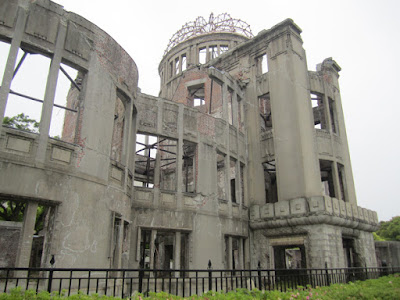In the spring of 1945, while WWII raged on, the United States was considering a two-stage land
invasion of Japan: in the southern island of Kyushu (where we just finished
cycling) in October 1945 and the main island of Honshu (where we're now biking)
in March 1946. Another option that was considered as a means to induce Japan to
surrender was use of the atomic bomb. This weapon had been devised as part of the
Manhattan project, whose center for atomic bomb development was in Los Alamos,
New Mexico.
For a variety of strategic reasons, the atomic bomb option
was chosen. A Target Committee identified four cities as optimal targets, and
on August 6, 1945, pilot Paul Tibbets took off in the Enola Gay (named for
Tibbet's mother) for the 6 hour flight from a United States airbase in Tinian
(a Pacific island near Guam) to Hiroshima. Hiroshima was unfortunate to have a
clear sky, so the bomb was dropped there instead of the secondary target of
Kokura (unlike the situation for the second atomic bombing three days later,
when Kokura was the primary target but was spared due to heavy cloud cover).
Hiroshima sustained massive damage, with 90,000 people dying
immediately and tens of thousands more dying by the end of 1945 from injuries
and the effects of radiation. Longer term ill effects included elevated cancer
rates in survivors, and study of these survivors has provided information about
the risk of malignancy as a function of radiation dose.
Hiroshima today, a modern city of about 1.1 million (with 2
million in the metropolitan area), has established a Peace Park with a museum
and memorials related to the atomic bomb attack, which we visited during our
short stay in the city. The museum has dramatic photographs of post-bombing Hiroshima, which had 69% of its buildings destroyed. The museum also focuses on
the movement for world peace and elimination of all nuclear weapons.
Unfortunately, it's hard to be optimistic about these goals. As an Australian
tourist at the museum said to us: "It's very depressing, since we never
learn from our past. If Iran gets the bomb, Israel will be the next atomic bomb
victim, and after that who knows where it will spread."
 |
| Hiroshima Peace Park |
 |
| Hiroshima Peace Clock Tower, whose bell rings every morning at 8:15 am, in memory of the exact time on August 6, 1945, that the atomic bomb was dropped on Hiroshima |
 |
| Peace Memorial Museum |

